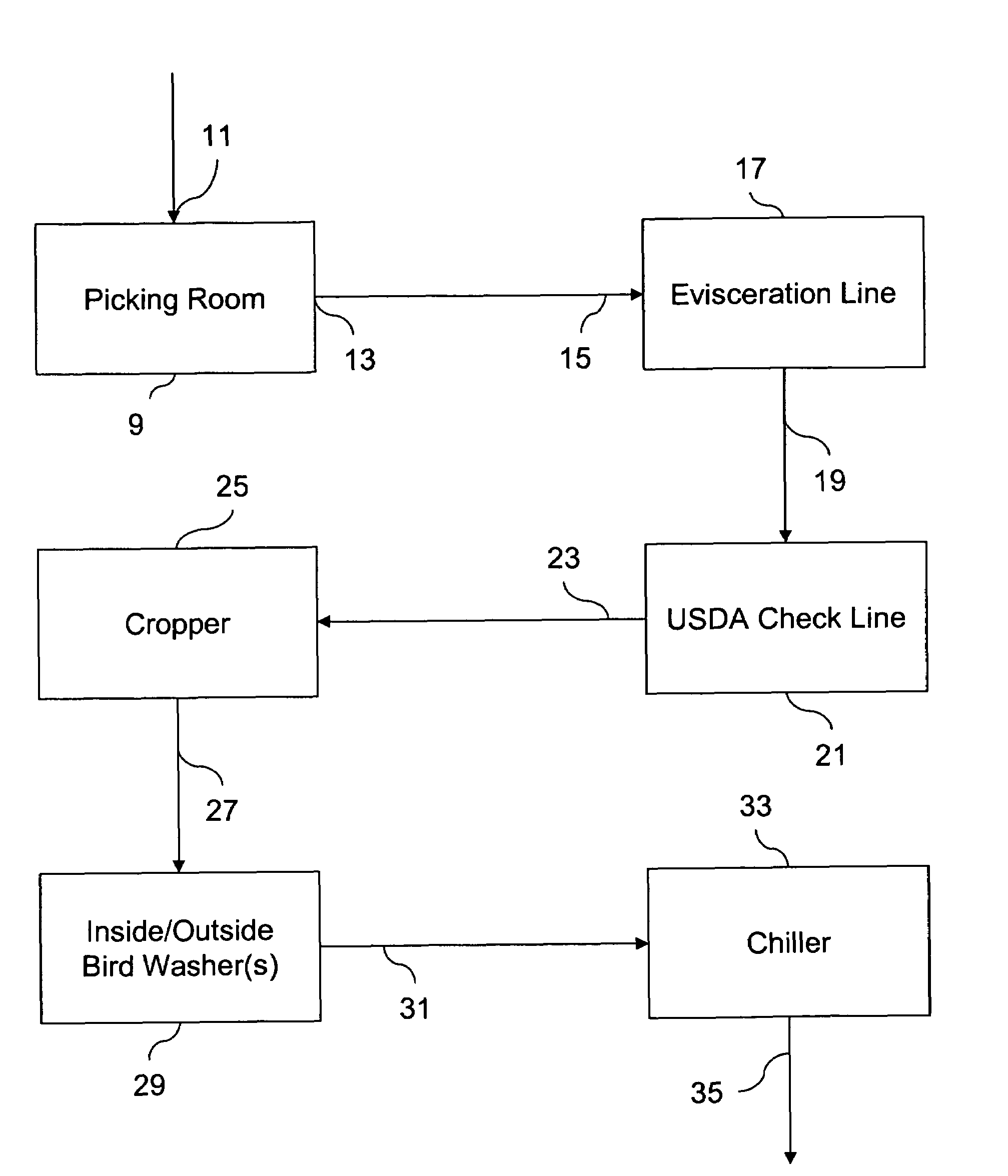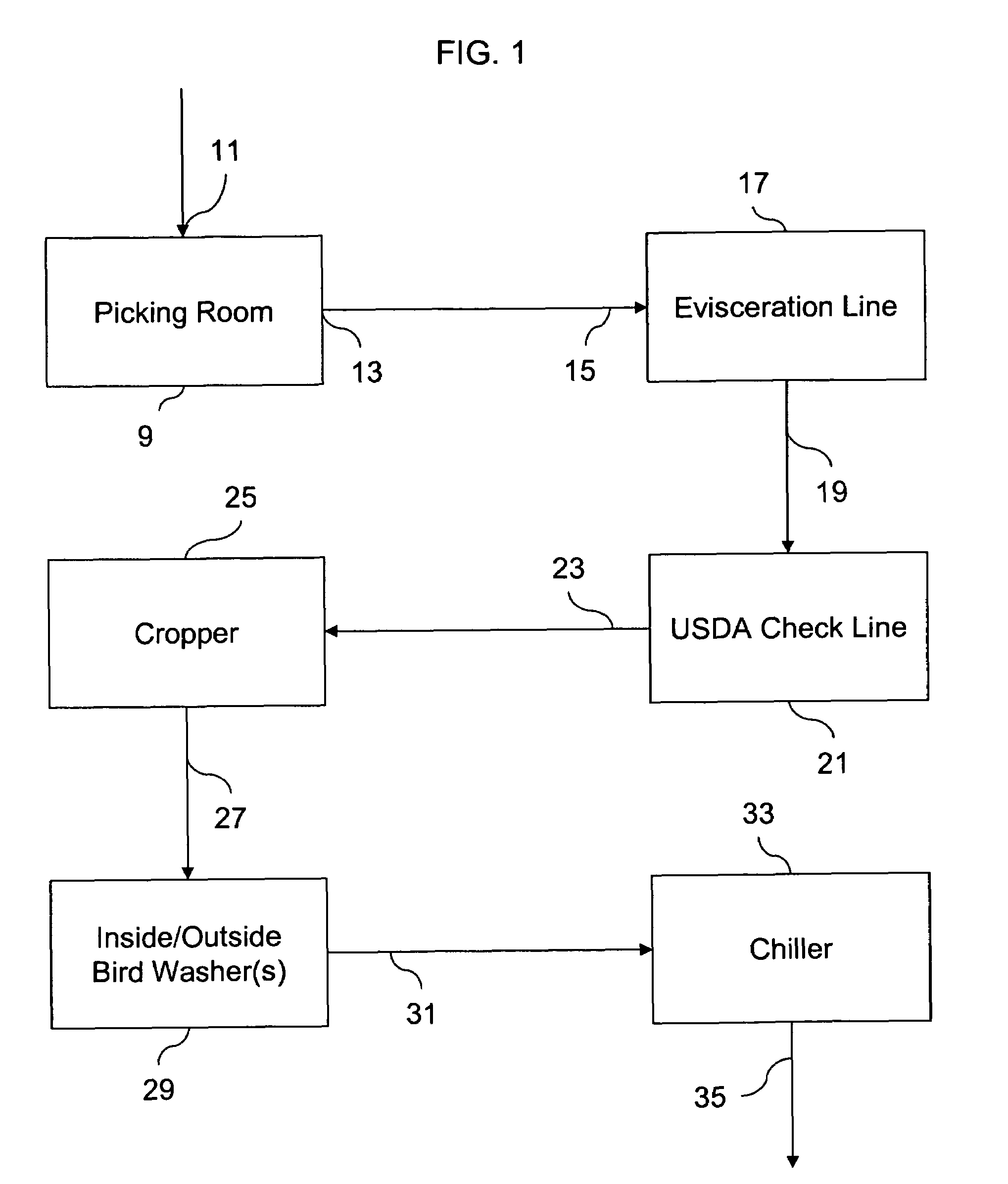Electrolyzed water treatment for poultry products
a technology of electrolyzed water and poultry products, applied in the field of poultry processing, can solve the problem that pathogens are unlikely to become resistant to electrolyzed water, and achieve the effect of improving the efficiency of electrolyzed water treatment and reducing the risk of contamination
- Summary
- Abstract
- Description
- Claims
- Application Information
AI Technical Summary
Benefits of technology
Problems solved by technology
Method used
Image
Examples
example 1
[0024]Both Type A and B water were applied to poultry carcasses. Type B water was applied in a shower; Type B water was applied again in a spray cabinet; and finally Type A water was applied in a spray cabinet. The spray application was accomplished with a spray manifold having eight spray heads in a single manifold.
[0025]The application of Type B water in the shower and spray cabinet was identical except for location. The Type B water had a pH of 11.0, an ORP of 900− mV, and an initial NaOH concentration of 25 ppm. Type B water was sprayed from a spray nozzle onto the carcasses from multiple angles for approximately 1.5 seconds at 35 psi and 7 gpm at a temperature of 50° C. The temperature of the solution was greater than the fat temperature of the poultry carcasses before application. The spray washing with Type B water occurred immediately following de-feathering or de-flocking and saponified the surfaces of the carcasses so that any fecal matter or other substances would not adh...
example 2
[0029]Both Type A and B water were applied to poultry carcasses. Type B water was applied by electrostatic spraying followed by Type A water by immersion.
[0030]Type B water was applied by electrostatic sprayer immediately after de-feathering or de-flocking the birds. The Type B water had a pH of 9.0-9.5, and an ORP of 850− mV, and an initial NaOH concentration 8-10 ppm. The Type B water was electrostatically sprayed on the carcass for 17 seconds, followed by a 45 minute dwell period at 4° C. in a chiller.
[0031]After removal from the chiller, Type A water was immediately applied to the carcasses by immersion or dipping. The Type A water had a pH of 1.9-2.4, an ORP of 1150+ mV, and an initial HOCl concentration of 8-10 ppm. The poultry carcasses were dipped into the Type A water for 60 minutes at a temperature of 20° C. The carcasses were agitated or shaken while immersed, which agitation was accomplished through an aeration device positioned underneath the carcasses being treated.
[00...
example 3
[0034]Type A water was applied to poultry carcasses. The carcasses were de-feathered or de-flocked and placed in a chiller. The Type A water was applied immediately after removal from the chiller and had a pH of 2.5, an ORP of 1150+ mV, and an initial HOCl concentration of 50 ppm. The poultry carcasses were dipped into the Type A water for approximately 10 minutes at a temperature of 2° C. The carcasses were agitated or shaken while immersed, which agitation was accomplished through an aeration device positioned underneath the carcasses being treated.
[0035]Table 4 summarizes the effect of the protocol of Example 3 on E. coli on chicken carcasses. CFU / cm2 stands for colony forming units per square centimeter, as understood by those of skill in the art. Any reduction in colony forming units is as compared to the chiller control.
[0036]
TABLE 4Effect of Electrolyzed Water by Immersion Against E. coli on BroilerChicken CarcassesInitialReductionTreatment(Log10 CFU / cm2)(Log10 CFU / cm2)Contro...
PUM
| Property | Measurement | Unit |
|---|---|---|
| oxidation reduction potential | aaaaa | aaaaa |
| oxidation reduction potential | aaaaa | aaaaa |
| oxidation reduction potential | aaaaa | aaaaa |
Abstract
Description
Claims
Application Information
 Login to View More
Login to View More - R&D
- Intellectual Property
- Life Sciences
- Materials
- Tech Scout
- Unparalleled Data Quality
- Higher Quality Content
- 60% Fewer Hallucinations
Browse by: Latest US Patents, China's latest patents, Technical Efficacy Thesaurus, Application Domain, Technology Topic, Popular Technical Reports.
© 2025 PatSnap. All rights reserved.Legal|Privacy policy|Modern Slavery Act Transparency Statement|Sitemap|About US| Contact US: help@patsnap.com


